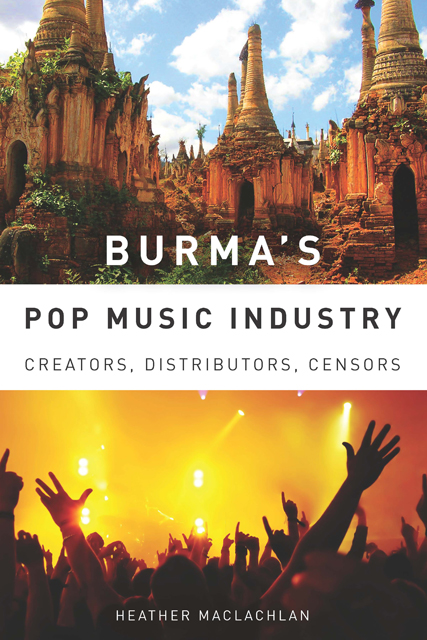Book contents
- Frontmatter
- Dedication
- Contents
- List of Illustrations
- Acknowledgments
- Introduction
- 1 The Creators of Burmese Pop Music
- 2 The Sound of Burmese Pop Songs
- 3 Learning Music in Burma Today
- 4 Six Facets of the Burmese Pop Music Industry
- 5 Musicians and the Censors: The Negotiation of Power
- Conclusion: The Significance of the Burmese Perspective
- Notes
- Bibliography
- Index
2 - The Sound of Burmese Pop Songs
Published online by Cambridge University Press: 11 February 2023
- Frontmatter
- Dedication
- Contents
- List of Illustrations
- Acknowledgments
- Introduction
- 1 The Creators of Burmese Pop Music
- 2 The Sound of Burmese Pop Songs
- 3 Learning Music in Burma Today
- 4 Six Facets of the Burmese Pop Music Industry
- 5 Musicians and the Censors: The Negotiation of Power
- Conclusion: The Significance of the Burmese Perspective
- Notes
- Bibliography
- Index
Summary
On February 16, 2008, I was among thousands of excited people attending an Iron Cross concert at Kandawgyi Park in Yangon. For the uninitiated (and this would exclude virtually every citizen of Burma), Iron Cross—or IC, as they are usually called—is the most famous and successful of contemporary Burmese rock bands. The group has sold many thousands of albums. The quickest way to mark IC’s success is to point out that the band has toured outside of Burma. In 2004, for example, they played dates in Japan and the United States. However, like the handful of other Burmese acts who have performed abroad, IC remains virtually unknown to the outside world. Its only audience is Burmese, at home and in the diaspora. That night, the excitement was palpable: the members of Iron Cross are veritable stars, almost heroic figures to their fans. Scalpers on the street hawked tickets for 5,000 kyat (or $5), a markup of 500 kyat from the official price.
My two companions and I abandoned our taxi at the gate, realizing that the crush of people would prevent us from advancing by car. As concert-goers surged past me, I noted that most seemed to be under thirty years of age; that men outnumbered women by about five to one; and that virtually no one was wearing a longyi (the traditional Burmese unisex skirt). Blue jeans were the uniform of the evening. And the slogans on t-shirts affirmed the wearers’ affinity for international youth culture: I saw numerous shirts celebrating David Beckham, Che Guevara, the FBI, and the US Army, and a few young men sported defiant slogans such as “F**K the Revolution” and “God Made Grass.” But I was most interested to see many people wearing the logos and names of pop bands. All of the groups represented were American and British bands; the misspelled Likin [Linkin] Park t-shirt was the most popular. There were no t-shirts representing any Burmese bands—even Iron Cross.
Arriving at the natural amphitheater where the stage was set up, we were enveloped by the crowd. There were no seats (as there had been for another concert I attended in the same venue a month earlier), and everyone was forced to stand. The luckiest were high up on the hills or very close to the stage.
- Type
- Chapter
- Information
- Burma's Pop Music IndustryCreators, Distributors, Censors, pp. 46 - 72Publisher: Boydell & BrewerPrint publication year: 2011

